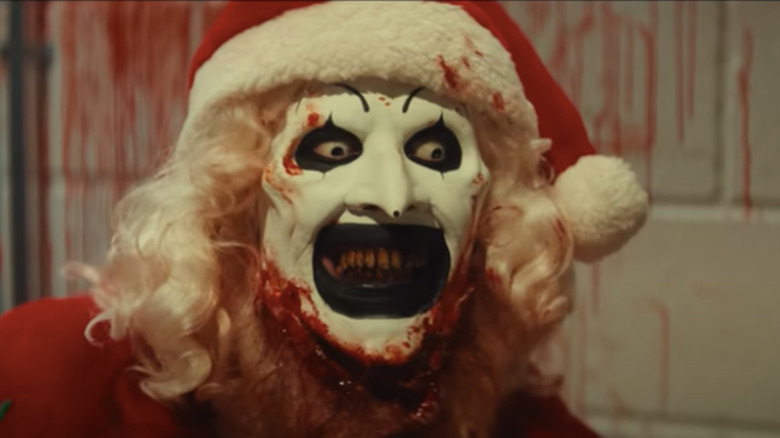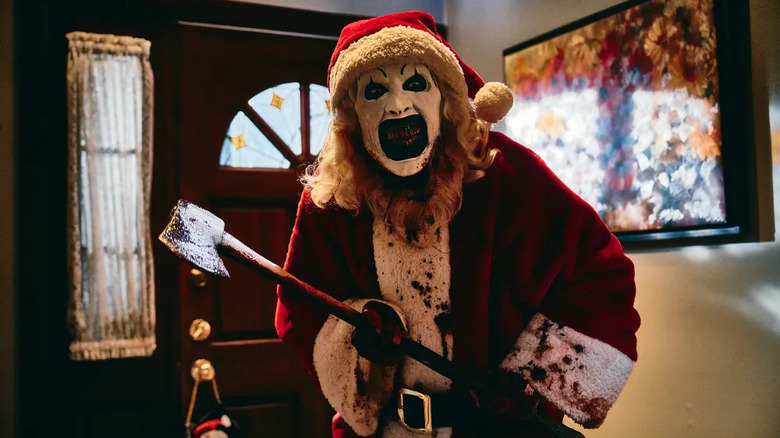This article contains spoilers for “Terrifier 3.”
The longer a horror franchise goes, the more lore needs to be developed, almost by default. After all, how else to explain why and how a series’ central villain/spirit/killer keeps coming back to pester the living? While some franchises have enough lore baked into the premise of the series and characters right from the get-go so as not to need too much elaboration — the Cenobites are called from Hell by the Lament Configuration, Charles Lee Ray is into voodoo resurrection, etc. — others find themselves having to pile new facets onto the characters to try and explain why this struggle of Good vs. Evil is continual. This latter group tends to contain most of the slasher franchises, as series like “Halloween” and “Friday the 13th” eventually find themselves either embracing explicitly supernatural ideas or having to shed continuity and start over.
Damien Leone’s “Terrifier” films are curiously right in between these two camps. While the first “Terrifier” movie features Art the Clown (David Howard Thornton) committing heinous acts of murder that any average human being could potentially do, by the end of that film there’s something explicitly supernatural happening that causes his resurrection. In “Terrifier 2,” Art is still ostensibly portrayed as human and isn’t given any supernatural powers per se, but his seeming ability to attack Sienna Shaw (Lauren LaVera) in her dreams along with all the hints toward Sienna’s father having some psychic (or otherwise) connection to Art sets the stage for some more supernatural shenanigans that follow. Although Leone explained a bit about such elements as Sienna’s own resurrection and the possession of Victoria Heyes (Samantha Scaffidi) on his commentary track for “Terrifier 2,” it was not until this month’s “Terrifier 3” that the lore of the series has been clearly laid out on-screen in the films.
The biggest revelation within “Terrifier 3” involves just what has gotten inside Victoria, why Art has seemingly become immortal, and what Sienna’s predestined part in this metaphysical drama is. Most illuminating is how these revelations explain Art’s role, not just in the film’s narrative but in the way the movies function, too, and it’s a reason that cleverly incorporates how the “Terrifier” movies are perceived in the real world.
Leone pokes at a well-worn slasher movie trope
The trope of the slasher killer routinely coming back to life after seemingly being left for dead is not only an old and well-worn one, it’s practically baked into the formula. John Carpenter’s “Halloween” from 1978 is the flashpoint where the subgenre coalesced, and Carpenter (along with co-writer Debra Hill) established the idea that perhaps the unknown forces of Pure Evil itself were responsible for Michael Myers being so hard to kill. As such, most slasher films made subsequent to “Halloween” took on this trope, sometimes going to great lengths to explain their killers’ resurrections, but other times just allowing for this latent supernatural ability to serve as a de facto explanation, as it were.
Leone has deliberately constructed the “Terrifier” movies to both comment upon and build on slasher and horror film history. In addition to various Easter eggs and homages, Leone uses the audience’s working knowledge of the rules of horror films (thanks, Wes Craven and Kevin Williamson) against them, subverting whatever he can at every turn. While Art returning from the dead at the end of “Terrifier” wasn’t a subversion in and of itself, the total lack of explanation as to why and how it was happening was, creating a vibe around the character that feels like he’s capable of anything. With “Terrifier 3,” Leone was interested in abandoning the ambiguity around Art’s abilities in favor of poking directly at that very trope and giving it an explicit, lore-based reason to occur. As the filmmaker recently told Screen Rant:
“It’s so different than anything that I’d seen in a slasher film before, and it was one of the things that excited me that I could really explore this supernatural aspect of the evil, and what brings your boogeyman back to life. Why do they suddenly become supernatural? I really wanted to explore that as if it was a character, instead of just glossing over and saying, ‘It’s just the trope. It’s what the boogeyman does.’ That’s become one of the most exciting things to me.”
Why Art the Clown cannot die, and what fuels his murderous deeds
As revealed in “Terrifier 3,” Art is the chosen servant of a Demon from Hell, an entity that initially appeared in “Terrifier 2” in the guise of the Little Pale Girl (Amelie McLain), whom only Art, Sienna, and Sienna’s brother Jonathan (Elliott Fullam) could see. Upon taking Art’s head after he was decapitated by Sienna, the Demon/Little Pale Girl possessed Victoria, the sole survivor of the first film who’d been defaced by Art and was left broken and driven mad enough to commit murder herself. Through her possession, the Demon not only takes over Victoria’s body but makes her give birth to a living version of Art’s head, allowing the killer to be literally reassembled at the start of “Terrifier 3.” Later, when Art and the Demon have Sienna in their clutches, the Demon explains how Sienna is the chosen one (i.e. only one) who can defeat Art with the mystical sword given to her by her late father, and that before this can be allowed to happen, the Demon intends to have Art sew enough discord and pain in Sienna’s life to break her spirit enough for the Demon to possess her body.
In other words, one of the tenets of the “Terrifier” series is its violence and extreme gore; our own review of “Terrifier 3” mentions this extensively, and many reactions to the films on social media all revolve around the graphic depictions. So, Leone has taken one of the elements of his series and built a lore reason around it: Art isn’t just brutally violent without motive, as it’s in creating so much upsetting violence that will allow him and the Demon to break down the defenses of Good forever. It doesn’t negate Art’s randomness, either, as his choice of victim can still be anyone at any time, in any fashion. It’s just that now we know that randomness is the point, as opposed to being incidental. It’s a rather ingenious way for “Terrifier” to have its cake and eat it too: Art can be a creepy, mysterious killer while serving a mythic, supernatural agenda. It allows the films to continue to indulge in over-the-top kill setpieces (which “Terrifier 3” certainly does) while claiming that such sequences explicitly serve the larger narrative. And while Art can certainly be called a minion of sorts who follows the Demon in this movie, the ending of “Terrifier 3” seems to indicate that all bets are off. Sure, the Demon (wherever it may be) likely has the same agenda, but who knows what a rudderless Art and Sienna will get up to for “Terrifier 4.” As with all of the “Terrifier” films, the delight lies within the surprises to come.
“Terrifier 3” is in theaters everywhere.







